Today’s ag economy makes knowledge and information key factors in making crop input decisions. Farmers can’t just try something because it may work or because it sounds good. Whatever inputs you are using, it is critical to not only make sure that it works, but that it works the best that it can. Take planter fertilizers and “starters.”
The theory in using starter fertilizer is that it gets the plant growing faster after emergence and that rapid establishment will enable better yield. However, some experts believe a faster start doesn’t necessarily mean a higher yield. So, who do you believe? Again, some education will help you make informed decisions.
As a fertilizer researcher for over 25 years, I believe education can lead to better decisions….but you don’t have to be an expert to evaluate the risks and benefits of starter fertilizer. AgroLiquid is fortunate to have a 1000-acre research farm, the North Central Research Station (NCRS), where replicated test plot experiments can be established in order to investigate fertility issues under a variety of conditions.
Planter fertilizer opportunities have been investigated routinely at the NCRS since 1994. Based on that research, we have identified the following considerations when deciding on whether starter fertilizers are the right choice for your farm:
Choose your weapon. Just like everything in agriculture, there is not a “one size fits all” approach to starters. Some fertilizers are “commodity” types that are commonly available, like 10-34-0, but can vary in price and quality (some good, some not-so-good). Others are private label, made by a company that promotes high quality along with other unique characteristics.
These are often higher in price per gallon, but that can be offset by lower use rates, higher yield and other characteristics such as cleanliness and ease of handling. An experiment at the North Central Research Station compared 3 gallon-per-acre rates of several in-furrow fertilizers and found the following yields.
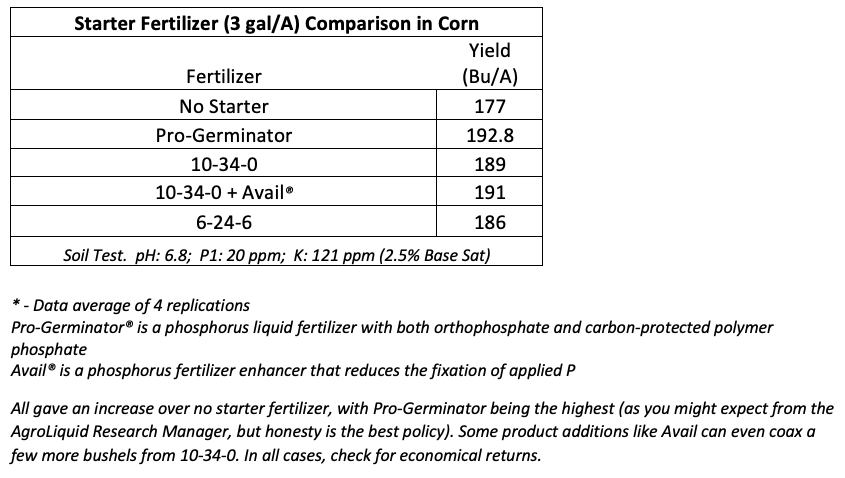
Know your target. You don’t use just any herbicide on all of your fields and hope it takes care of the weeds you have. You select what fits your needs. The same should apply to starter fertilizers. I used to think that you just apply an in-furrow application of a fertilizer with a little N for an early push and some P for roots and you are good to go. But, research at the NCRS shows that you can improve results if your starter reflects what the whole plant nutrient needs are based on the soil test. Fields in this area are low in potassium (K), and the addition of some K fertilizer to the nitrogen and phosphorus starter saw an increased yield over that with phosphorus fertilizer alone.
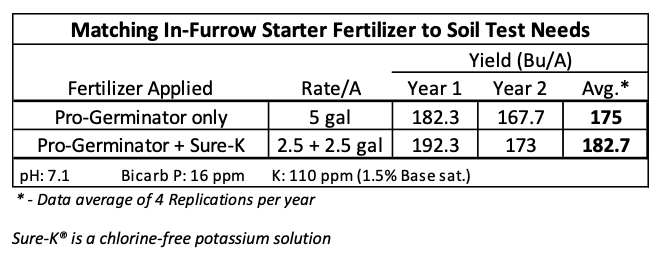
Further adjustment of the product mix ratio can have even greater results, particularly at higher fertilizer application rates. In another field with soil that is high in P (51 ppm) and low in K (71 ppm or 1.5% base saturation), a much higher yield was obtained when the 10 gallons per acre fertilizer mix was heavier to the K side (70% Sure-K vs 40% Sure-K). Same volume, just different P and K fertilizer content where increased fertilizer K in soil with low testing soil K increased yield by an average of over 13 bushels per acre.

Make the correct diagnosis and take a complete soil test. If you are going to fertilize for a specific nutrient shortage, make sure it’s the right one. A few years ago, I visited a field that was showing sulfur deficiency, even though ample sulfur had been applied in the form of spring broadcast ammonium sulfate and a liquid in-furrow sulfur fertilizer. When I got there, the field was indeed showing yellowing which was thought to be from sulfur deficiency. I asked for the soil test and, you guessed it, no test for micros. The soil test sulfur was not bad, but the assumption was that previous yellow corn in this field had to be due to low sulfur. I sent soil and corn tissue samples to a lab. When the report came back, it indicated a severe manganese deficiency. This was the cause of the yellow corn. This misdiagnosis was costly in two ways: extra fertilizer money was spent for something that wasn’t needed and there was a yield loss from not putting on the correct, needed nutrient.
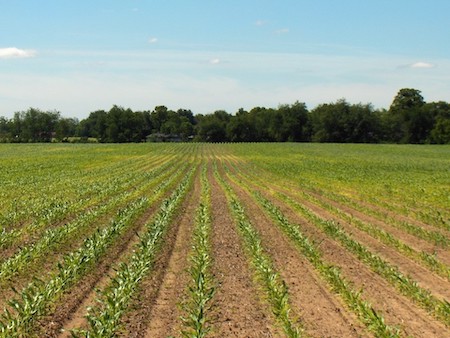
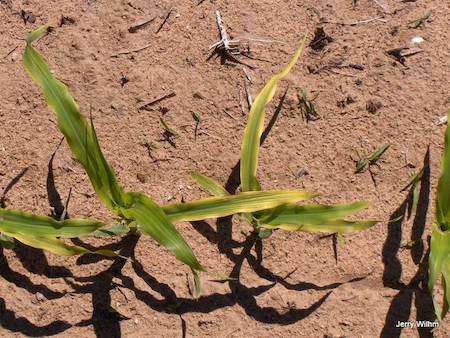
(Photos) This crop’s manganese deficiency was misdiagnosed as a sulfur deficiency. This shows why a complete soil test is needed and how important micronutrients are.
Take advantage of in-furrow placement for more than just N-P-K. At the NCRS, we have shown a starter fertilizer shouldn’t be expected to work without needed micronutrients. In this picture of soybeans (below), we are looking at the outside rows of two plots. Both plots received a planter application of 5 gallons per acre of a 3-8-13 liquid fertilizer. The plot row on the right is showing severe manganese (Mn) deficiency but the plot on the left received a foliar application of a 4% manganese fertilizer along with an application of Roundup. Even with the applied fertilizer, it’s critical to not overlook the micronutrients. In the end, the plots that received the foliar application had double the yield of the plots with Mn deficiency (35 bu/A vs 17 bu/A).
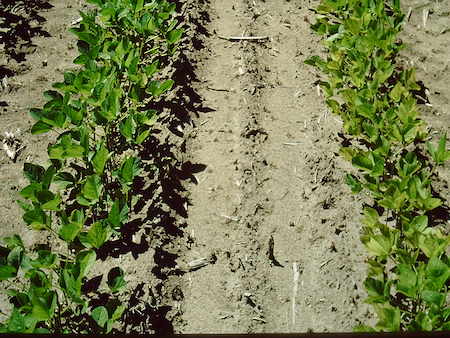
You can certainly broadcast some micros, but I like to take advantage of the in-furrow placement for micronutrient application. After all, they are usually applied at low rates, so why not place them where you are sure to get the most uptake: with the seed! There are a number of micronutrient sources for in-furrow, some better than others.
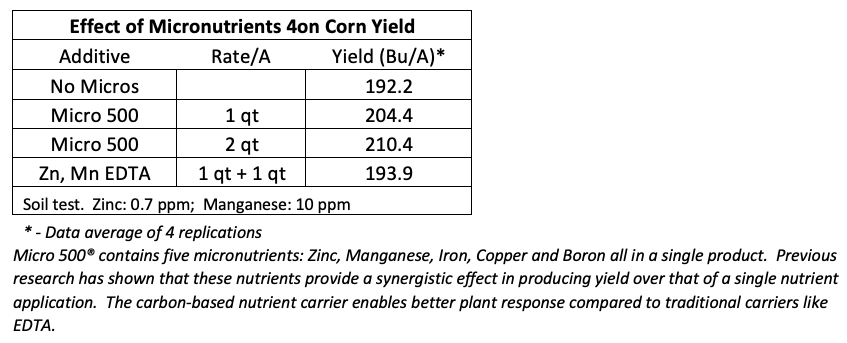
Armed with a little knowledge on how to choose the right starter program, as well as knowing where you are and where you want to go with yields, will help make informed decisions for your farm.
Jerry Wilhm grew up in Oklahoma and worked at the Oklahoma State University agronomy research farm as an undergraduate at OSU. This inspired him to pursue a career in agricultural research. He obtained his B.S. and M.S. degrees in Agronomy (Weed Science) from Oklahoma State University, and his Ph.D. in Crop and Soil Science from Michigan State University. Wilhm has focused on crop nutrient research since joining AgroLiquid in 1992. As the company’s senior research manager, Wilhm oversees the 1,000-acre North Central Research Station, which is focused on crop nutrient research.
Strip-Till Farmer's Focusing on Smarter, Sustainable Fertilizing Strategies series is brought to you by AgroLiquid.
For over 35 years, AgroLiquid has been on a mission to engineer the best plant nutrition products while safeguarding your crops, the soil and the environment. Click here to learn more about AgroLiquid's suite of fertilizer products and agronomic services.






